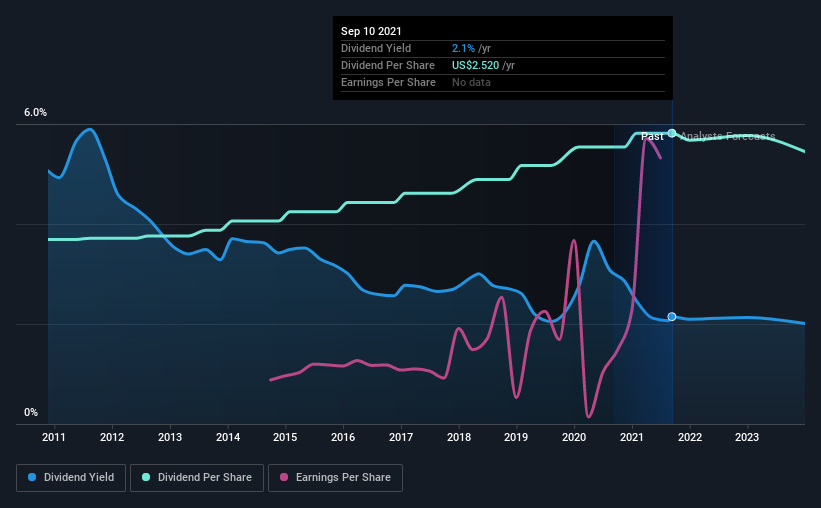Why You Might Be Interested In Cincinnati Financial Corporation (NASDAQ:CINF) For Its Upcoming Dividend – Nasdaq
Cincinnati Financial Corporation (NASDAQ:CINF) stock is about to trade ex-dividend in three days. The ex-dividend date occurs one day before the record date which is the day on which shareholders need to be on the company’s books in order to receive a dividend. The ex-dividend date is important because any transaction on a stock needs to have been settled before the record date in order to be eligible for a dividend. Therefore, if you purchase Cincinnati Financial’s shares on or after the 15th of September, you won’t be eligible to receive the dividend, when it is paid on the 15th of October.
The company’s upcoming dividend is US$0.63 a share, following on from the last 12 months, when the company distributed a total of US$2.52 per share to shareholders. Looking at the last 12 months of distributions, Cincinnati Financial has a trailing yield of approximately 2.1% on its current stock price of $117.38. Dividends are an important source of income to many shareholders, but the health of the business is crucial to maintaining those dividends. So we need to investigate whether Cincinnati Financial can afford its dividend, and if the dividend could grow.
Dividends are typically paid from company earnings. If a company pays more in dividends than it earned in profit, then the dividend could be unsustainable. Cincinnati Financial is paying out just 14% of its profit after tax, which is comfortably low and leaves plenty of breathing room in the case of adverse events.
Generally speaking, the lower a company’s payout ratios, the more resilient its dividend usually is.
Click here to see the company’s payout ratio, plus analyst estimates of its future dividends.

Have Earnings And Dividends Been Growing?
Stocks in companies that generate sustainable earnings growth often make the best dividend prospects, as it is easier to lift the dividend when earnings are rising. If earnings fall far enough, the company could be forced to cut its dividend. That’s why it’s comforting to see Cincinnati Financial’s earnings have been skyrocketing, up 36% per annum for the past five years.
Many investors will assess a company’s dividend performance by evaluating how much the dividend payments have changed over time. Since the start of our data, 10 years ago, Cincinnati Financial has lifted its dividend by approximately 4.6% a year on average. Earnings per share have been growing much quicker than dividends, potentially because Cincinnati Financial is keeping back more of its profits to grow the business.
To Sum It Up
From a dividend perspective, should investors buy or avoid Cincinnati Financial? Companies like Cincinnati Financial that are growing rapidly and paying out a low fraction of earnings, are usually reinvesting heavily in their business. This is one of the most attractive investment combinations under this analysis, as it can create substantial value for investors over the long run. Cincinnati Financial ticks a lot of boxes for us from a dividend perspective, and we think these characteristics should mark the company as deserving of further attention.
With that in mind, a critical part of thorough stock research is being aware of any risks that stock currently faces. Our analysis shows 1 warning sign for Cincinnati Financial and you should be aware of it before buying any shares.
A common investment mistake is buying the first interesting stock you see. Here you can find a list of promising dividend stocks with a greater than 2% yield and an upcoming dividend.
This article by Simply Wall St is general in nature. We provide commentary based on historical data and analyst forecasts only using an unbiased methodology and our articles are not intended to be financial advice. It does not constitute a recommendation to buy or sell any stock, and does not take account of your objectives, or your financial situation. We aim to bring you long-term focused analysis driven by fundamental data. Note that our analysis may not factor in the latest price-sensitive company announcements or qualitative material. Simply Wall St has no position in any stocks mentioned.
Have feedback on this article? Concerned about the content? Get in touch with us directly. Alternatively, email editorial-team (at) simplywallst.com.
The views and opinions expressed herein are the views and opinions of the author and do not necessarily reflect those of Nasdaq, Inc.
Simply Wall St
We help you make informed decisions by giving you access to institutional quality data and analysis presented visually.






